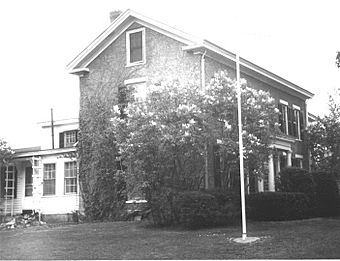Liberty Farm facts for kids
|
Liberty Farm
|
|

Liberty Farm in 1973
|
|
| Location | Worcester, Massachusetts |
|---|---|
| Built | c. 1810 |
| Architectural style | Federal |
| MPS | Worcester MRA |
| NRHP reference No. | 74002046 |
Quick facts for kids Significant dates |
|
| Added to NRHP | September 13, 1974 |
| Designated NHL | May 30, 1974 |
Liberty Farm is a very important historic house in Worcester, Massachusetts. It was built around 1810. This house was the home of Abby Kelley Foster (1810–1887) and Stephen Symonds Foster (1809-1881). They were famous activists who fought to end slavery and for women's rights.
The Fosters used Liberty Farm as a safe place for enslaved people escaping to freedom. This was part of the secret network known as the Underground Railroad. They also famously refused to pay taxes on their property. They did this because Abby, as a woman, was not allowed to vote. Liberty Farm is a private home and is not open to the public. It was named a National Historic Landmark in 1974.
Contents
Liberty Farm: A Special Historic Home
Liberty Farm is a two-and-a-half-story brick house. It was built around 1810 in the Federal style. Today, it stands in a suburban area of western Worcester, Massachusetts. The front of the house has five window sections. The main door is in the center and has a small porch with columns. The doorway also has windows on the sides and a fan-shaped window above.
A wooden addition extends from the right side of the main house. Another addition goes towards the back. These parts were likely added in the early 1900s. Inside, the main house still looks much like it did long ago. It has beautiful fireplace decorations.
Who Were Abby and Stephen Foster?
Abby Kelley Foster and Stephen Symonds Foster were a powerful team. They dedicated their lives to making America a fairer place. They fought for freedom for all people.
Abby Kelley Foster's Fight for Justice
Abby Kelley Foster was born in Pelham, Massachusetts. She grew up in the Quaker faith. Quakers believed in equality for everyone. Abby first worked as a teacher at a Quaker school.
By the 1830s, she joined the local anti-slavery group. She began speaking out for the immediate end of slavery. In 1838, she left teaching to work full-time for these causes. She became a close friend of William Lloyd Garrison. He was a major leader in the anti-slavery movement.
In 1840, Abby was chosen for a leadership role. She joined the executive committee of the American Anti-Slavery Society. Some members did not like women in leadership. But Abby was elected anyway. She traveled all over the northern United States. She spoke strongly against slavery and for women's rights.
Stephen Symonds Foster's Activism
Stephen Symonds Foster grew up in New Hampshire. He also became involved in the anti-slavery cause. He worked with William Lloyd Garrison, just like Abby. Abby and Stephen met in the early 1840s. They got married in 1845.
Both continued to be strong activists for their beliefs. They had to slow down their travels a bit after their only child was born in 1847. This was the same year they bought Liberty Farm.
Liberty Farm: A Center for Change
The Fosters managed a very successful farm at Liberty Farm. But they also used their property to support their political work. They offered shelter to enslaved people escaping to freedom. This made Liberty Farm a station on the Underground Railroad.
They also refused to pay taxes on their property. This was because Abby could not vote. This act of civil disobedience meant their property was sold at tax auctions many times. However, their supporters would buy it back. Then they would give it right back to the Fosters.
The Fosters lived at Liberty Farm for many years. Stephen passed away in 1881. After his death, Abby lived with her sister in Worcester.



